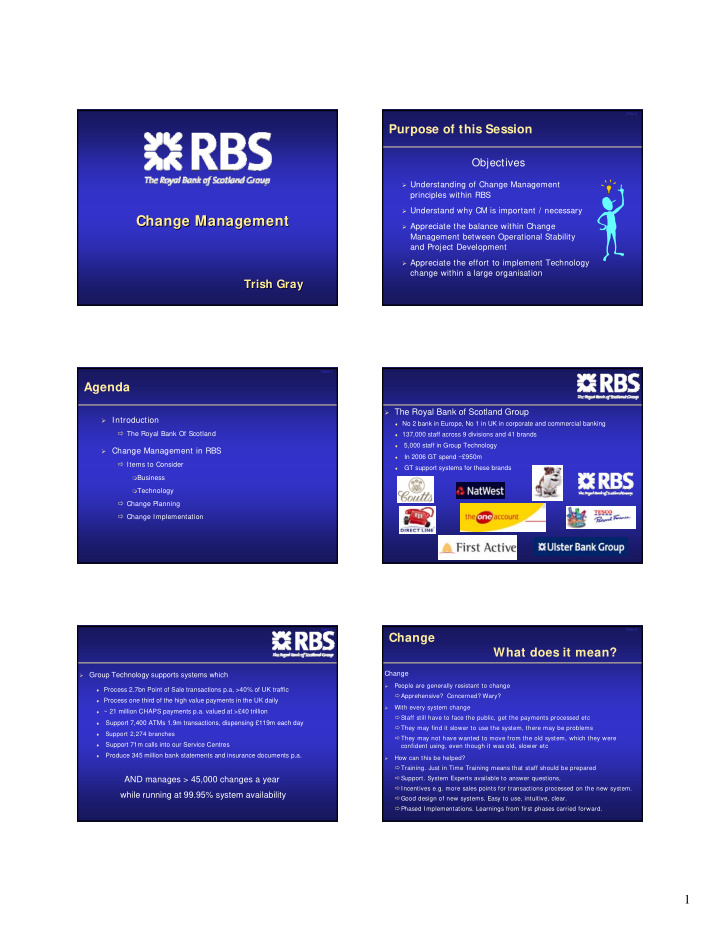



Slide 2 Purpose of this Session Objectives � Understanding of Change Management principles within RBS � Understand why CM is important / necessary Change Management Change Management Change Management � Appreciate the balance within Change Management between Operational Stability and Project Development � Appreciate the effort to implement Technology change within a large organisation Trish Gray Trish Gray Trish Gray Slide 3 Slide 4 Agenda � The Royal Bank of Scotland Group � Introduction ♦ No 2 bank in Europe, No 1 in UK in corporate and commercial banking � The Royal Bank Of Scotland ♦ 137,000 staff across 9 divisions and 41 brands ♦ 5,000 staff in Group Technology � Change Management in RBS ♦ In 2006 GT spend ~£950m � Items to Consider ♦ GT support systems for these brands � Business � Technology � Change Planning � Change Implementation Slide 5 Slide 6 Change What does it mean? Change � Group Technology supports systems which � People are generally resistant to change ♦ Process 2.7bn Point of Sale transactions p.a, >40% of UK traffic � Apprehensive? Concerned? Wary? ♦ Process one third of the high value payments in the UK daily � With every system change ♦ ~ 21 million CHAPS payments p.a. valued at >£40 trillion � Staff still have to face the public, get the payments processed etc ♦ Support 7,400 ATMs 1.9m transactions, dispensing £119m each day � They may find it slower to use the system, there may be problems ♦ Support 2,274 branches � They may not have wanted to move from the old system, which they were ♦ Support 71m calls into our Service Centres confident using, even though it was old, slower etc ♦ Produce 345 million bank statements and insurance documents p.a. � How can this be helped? � Training. Just in Time Training means that staff should be prepared � Support. System Experts available to answer questions, AND manages > 45,000 changes a year � Incentives e.g. more sales points for transactions processed on the new system. while running at 99.95% system availability � Good design of new systems. Easy to use, intuitive, clear. � Phased Implementations. Learnings from first phases carried forward. 1
Slide 7 Slide 8 What type of changes ? Change Management The Balancing Act � Ulster Bank Integration � Total change for 272 branches � Happened over 1 weekend � Involved more than 1,000 staff co-ordinating the event � Customer Account Opening � Changes to Branch, Telephone and Internet channels � Changes to Natwest, Ulster Bank and RBS � Used by 16,000 staff and many thousand customers � Impacts 2,274 branches, all Telephone Advisory Service Centres Development teams are measured on getting change implemented ATM Changes Support teams are measured on system availability � � The User is YOU. When the option screen changes, get customer queries. But Change can cause problems � Timing very important. Nobody likes the ATM network to be out of service And often it is the business users who take the impact Slide 9 Slide 10 Change Management Change Management The Balance Costs On average 4,000 changes every month within the main GT Datacentre � � Adds time to the delivery We take a 12 - 18 month view of forthcoming changes � � Each 0.01% of stability comes with a cost � Complex Timeline, balancing of changes with Benefits � Assured Disaster Recovery – Requirement of Financial Services Authority � Month End processing, Bank Holidays � Provides excellent control. Without it there would be chaos � Big Implementations � Maintains a high level of stability in existing systems � Maintenance Schedules � de-risks Change � External requirements, e.g. Swift deadlines, Statutory changes (CCA, ICOB) � Ensures that staff are ready to receive the change. � Logistics e.g. access to get kit installed, length of rollout, number of areas The Balance requiring access at any one time. Training of staff. Business planning. � Accepting a level of risk around certain changes, while concentrating on the Change Board - Twice weekly review of all changes going in over the next � high risk elements week. High risk changes have to be presented / explained � Ensuring everything is planned, contingency in place, communications etc. � Risk Mitigation - what steps can be taken to remove risk from the changes Very formalised, but a lot safer. Slide 11 Slide 12 Change Management Change Management I tems to Consider I tems to Consider Business Perspective Technology Perspective � Change – Consideration of how will it be received? � Timing of changes alongside other implementations, system outages etc � Training - Could be 16,000 members of staff to train. � Risk of change on other systems � How / where system will be deployed � Incident Management � Changes to business operating model, handoffs between branches and centres � Fit For Production – � Has it been fully tested? System test, UAT, Performance , Operability, Penetration … � User set up � Does it conform to standards. Can it be absorbed into the live environment? Timing of changes alongside other project changes � � Are the right people available to support the implementation and live running � Communication to staff and customers � Back Out � Printed Output development / management � how long will it take? when is the latest time it can start? Logistics e.g. stationery, printing of inserts � who will be impacted? About 1-2% of changes fail at implementation. Of those about 1/3 � cause Service Impacting problems System proving e.g. agreement of live proving data with credit organisations � � Be prepared. Have several backout strategies. One may not be enough Risk Strategies : what happens if there are problems, before or after the change? � � Business Support. Staff to prove system changes, provide support etc 2
Recommend
More recommend